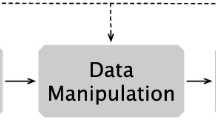Abstract
Visualization of information after retrieval from the World Wide Web is a very challenging task because of the huge amount of data in cyberspace. Based on rules, information is retrieved through mining techniques and then visualized in different ways. The web-graph is one way for users to visualize web data and its connectivity. But because of its huge size, the web-graph lacks simplicity for end users. Though clustering plays a very important role in reducing the complexity of the web graph by making it compact and simple, existing clustering techniques are insufficient to provide personalized visualization for users. Hence, these clustering techniques end up showing the same clustered graph to every user, despite their varying interests. This work aims to make information visualization personalized based on user interests; to provide a good first impression of web information to end users; to make web navigation easier; and to create scope for further analysis. Specifically, we develop a system for clustering which first considers user interests and then visualizes the clustered web graph to make the information more useful to the end users. In this paper, we present some experimental examples that show the improvements achieved by our approach over existing ones.
Similar content being viewed by others
References
Keim D, Mansmann F, Schneidewind J, et al. Challenges in visual data analysis. In: International Conference on Information Visualization, London, 2006. 9–16
Card S. Information visualization. In: Sears A, Jacko J A, eds. The Human-Computer Interaction Handbook: Fundamentals, Evolving Technologies, and Emerging Applications. 2nd ed. New York: Lawrence Erlbaum Assoc. Inc., 2008
Huang X, Eades P, Lai W. A framework of filtering, clustering and dynamic layout graphs for visualization. In: Australasian Conference on Computer Science, Darlinghurst, 2005. 87–96
Rattigan M J, Maier M, Jensen D. Graph clustering with network structure indices. In: International Conference on Machine Learning. New York: ACM, 2007. 783–790
Gao J. Enhancing web network information visualization with structure and content based clusterings. Dissertation for the Doctoral Degree. Hawthorn: Swinburne University of Technology, 2010
Liu H, Lieberman H, Selker T. GOOSE: A goal-oriented search engine with commonsense. In: Proceedings of the 2nd International Conference on Adaptive Hypermedia and Adaptive Web-Based Systems, Malaga, 2002. 253–263
Wang X, Zhai C. Learn from web search logs to organize search results. In: ACM SIGIR Conference on Research and Development in Information Retrieval, New York, 2007. 87–94
Agrawal R, Gollapudi S, Halverson A, et al. Diversifying search results. In: ACM International Conference on Web Search and Data Mining, New York, 2009. 5–14
Agichtein E, Zheng Z. Identifying ‘best bet’ web search results by mining past user behavior. In: ACM SIGKDD International Conference on Knowledge Discovery and Data Mining, New York, 2006. 902–908
Smyth B, Balfe E, Boydell O, et al. A live-user evaluation of collaborative web search. In: Kaelbling L P, Saffiotti A, eds. International Joint Conferences on Artificial Intelligence. Edinburgh, 2005. 1419–1424
Qiu F, Cho J. Automatic identification of user interest for personalized search. In: International Conference on World Wide Web, Edinburgh, 2006. 727–736
Joung Y S, El Zarki M, Jain R. A user model for personalization services. In: International Conference on Digital Information Management, Ann Arbor, 2009. 1–6
Micarelli A, Gasparetti F, Sciarrone F, et al. Personalized search on the World Wide Web. In: Brusilovsky P, Kobsa A, Nejdl W, eds. The Adaptive Web. Berlin/Heidelberg: Springer-Verlag, 2007. 195–230
Gauch S, Speretta M, Chandramouli A, et al. User profiles for personalized information access. In: Brusilovsky P, Kobsa A, Nejdl W, eds. The Adaptive Web. Berlin/Heidelberg: Springer-Verlag, 2007. 54–89
Lin D. An information-theoretic definition of similarity. In: International Conference on Machine Learning. San Francisco: Morgan Kaufmann Publishers Inc., 1998. 296–304
Gauch S, Chaffee J, Pretschner A. Ontology-based personalized search and browsing. Web Intell Agent Syst, 2003, 1: 219–234
Author information
Authors and Affiliations
Corresponding author
Rights and permissions
About this article
Cite this article
Saleheen, S., Lai, W. User centric dynamic web information visualization. Sci. China Inf. Sci. 56, 1–14 (2013). https://doi.org/10.1007/s11432-013-4871-0
Received:
Accepted:
Published:
Issue Date:
DOI: https://doi.org/10.1007/s11432-013-4871-0




